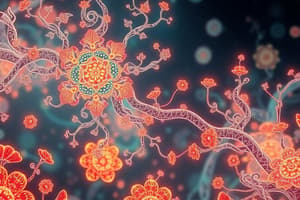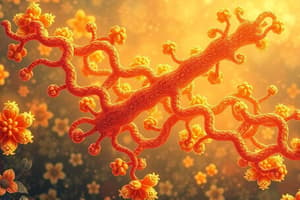Podcast
Questions and Answers
What structural feature is characteristic of receptor tyrosine kinases?
What structural feature is characteristic of receptor tyrosine kinases?
- Two transmembrane helices
- N-terminal intracellular binding site
- C-terminal extracellular binding site
- Single transmembrane helix (correct)
Which component of the receptor tyrosine kinases is primarily responsible for ligand binding?
Which component of the receptor tyrosine kinases is primarily responsible for ligand binding?
- Tyrosine kinase domain
- Transmembrane helix
- N-terminal extracellular binding site (correct)
- C-terminal intracellular binding site
Which of the following accurately describes the role of the tyrosine kinase domain?
Which of the following accurately describes the role of the tyrosine kinase domain?
- It initiates intracellular signaling through phosphorylation (correct)
- It facilitates ligand binding
- It forms a transmembrane channel for ions
- It serves as a structural support for the receptor
What is the primary function of the C-terminal intracellular binding site in receptor tyrosine kinases?
What is the primary function of the C-terminal intracellular binding site in receptor tyrosine kinases?
What is a crucial step in the activation process of receptor tyrosine kinases?
What is a crucial step in the activation process of receptor tyrosine kinases?
How does ligand binding affect receptor tyrosine kinases?
How does ligand binding affect receptor tyrosine kinases?
Which chemical groups are involved in the active site of the tyrosine kinase domain?
Which chemical groups are involved in the active site of the tyrosine kinase domain?
What is the consequence of abnormal activation of receptor tyrosine kinases?
What is the consequence of abnormal activation of receptor tyrosine kinases?
What is the primary function of the C-terminal intracellular binding site of receptor tyrosine kinases?
What is the primary function of the C-terminal intracellular binding site of receptor tyrosine kinases?
Which part of the receptor tyrosine kinase is directly involved in ligand binding?
Which part of the receptor tyrosine kinase is directly involved in ligand binding?
What biological process is primarily associated with the activity of receptor tyrosine kinases?
What biological process is primarily associated with the activity of receptor tyrosine kinases?
How does the transmembrane helix contribute to the function of receptor tyrosine kinases?
How does the transmembrane helix contribute to the function of receptor tyrosine kinases?
During the activation of receptor tyrosine kinases, what is the result of ligand binding to the N-terminal binding site?
During the activation of receptor tyrosine kinases, what is the result of ligand binding to the N-terminal binding site?
Which amino acid is specifically associated with the kinase activity of receptor tyrosine kinases?
Which amino acid is specifically associated with the kinase activity of receptor tyrosine kinases?
What role does the extracellular binding domain of receptor tyrosine kinases play in cellular signaling?
What role does the extracellular binding domain of receptor tyrosine kinases play in cellular signaling?
What is the consequence of tyrosine kinase activity in receptor tyrosine kinases?
What is the consequence of tyrosine kinase activity in receptor tyrosine kinases?
Which part of the receptor tyrosine kinase structure is responsible for ligand binding?
Which part of the receptor tyrosine kinase structure is responsible for ligand binding?
What is the primary function of the intracellular domain of receptor tyrosine kinases?
What is the primary function of the intracellular domain of receptor tyrosine kinases?
Which of the following statements correctly describes a component of receptor tyrosine kinases?
Which of the following statements correctly describes a component of receptor tyrosine kinases?
Which of the following is NOT typically a ligand for receptor tyrosine kinases?
Which of the following is NOT typically a ligand for receptor tyrosine kinases?
What is the role of the transmembrane helix in receptor tyrosine kinases?
What is the role of the transmembrane helix in receptor tyrosine kinases?
Which amino acid is directly involved in the kinase activity of receptor tyrosine kinases?
Which amino acid is directly involved in the kinase activity of receptor tyrosine kinases?
What structural feature is characteristic of the binding sites in receptor tyrosine kinases?
What structural feature is characteristic of the binding sites in receptor tyrosine kinases?
How do receptor tyrosine kinases typically become activated?
How do receptor tyrosine kinases typically become activated?
Flashcards are hidden until you start studying
Study Notes
Receptor Tyrosine Kinases
- Receptor tyrosine kinases are transmembrane receptors that bind ligands on the exterior of the cell.
- These receptors have an extracellular domain, a transmembrane domain, and an intracellular domain.
- The extracellular domain binds ligands such as growth factors, hormones, and cytokines.
- The transmembrane domain holds the receptor in the cell membrane.
- The intracellular domain has tyrosine kinase activity, which means it can add a phosphate group to tyrosine amino acids on other proteins.
- Ligands binding to the extracellular domain activates the tyrosine kinase activity of the receptor.
- This activation triggers a signaling cascade inside the cell, leading to various cellular responses like cell growth, differentiation, and survival.
- The tyrosine kinase domain has four main chemical groups:
- Amino group (1)
- Carboxyl group (2)
- Alpha carbon (3)
- Variable side chain (4)
Studying That Suits You
Use AI to generate personalized quizzes and flashcards to suit your learning preferences.




